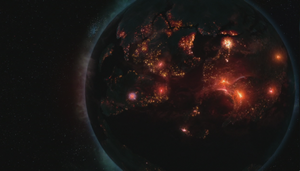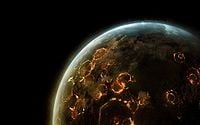Glassing
From Halopedia, the Halo wiki
- "You are...all of you...vermin. Cowering in the dirt thinking... what, I wonder? That you might escape the coming fire? No. Your world will burn ts surface is but glass!"
- — Prophet of Truth

[[Image:Halo3 E3 TRAILER 2007 720pheir Plasma Weaponry. The superheated plasma "bolts" discharge, striking the surface and converting the top soil and other surface geology into a mineral called lechatelierite that is similar to glass, hence its name. The process also vaporizes any bo notably during the Battle of Pegasi Delta[1] and the glassing As a result of the destruction, the atmosphere of most planets have been known to boil away from the process[2], though not all planets suffer this, the most notable example being Reach. killed by the intense heat. As thermal expansion takes over, the resulting flames fan out and create a pyroclastic surge,<rves the planet unable to recover to its former state.

Throughout the Human-Covenant War, the Covenant aggressors glassed a significant majority of the UNSC's colony worlds from orbit. And although ground forces were invariably deployed first, as UNSC forces were routed in space, the bombardment would commence.[3] The first planet to suffer this fate was Harvest, glassed from the Jiralhanae-operated cruiser Rapid Conversion.[4] It has been noted that areas of interest to the Covenant are left intact for reasons of study or retrieval; however, this is not common, as only three planets have been partially glassed and only when a Forerunner Artifact was discovered.[5] After the Covenant glasses a planet, a shard of glass is removed and placed in the Step of Silence within High Charity, where it hangs with hundreds of other shards from worlds glassed by the Covenant.[6]
The Second Battle of Earth culminated in the glassing of the city of Voi in Africa by Covenant Separatists, in an effort to contain a Flood infestation which had come to Earth only hours earlier. [7] Lord Hood accuses the Sangheili lead fleet of glassing half of the continent, but given his distaste for his former enemies, he might have exaggerated about the actual extent of the glassing. This is supported by the fact that the area around Kilimanjaro seems relatively intact during the ceremony at the end of the game. It is unknown what other areas of the Earth, if any, were glassed by the Covenant prior to their abandonment of the planet and the arrival of the Sangheili.
Halo Wars
In Halo Wars, the Prophet of Regret faction of the Covenant are able to use the Prophet to call down a Cleansing Beam from an orbiting Covenant ship. Rather than a leader power, this is treated as the unit's secondary ability, using the Y button to guide the beam at the cost of resources every second. It lacks the power of typical glassing maneuvers seen in past canon to balance gameplay.
Trivia
- By the end of Operation: FIRST STRIKE and Halo 2, the Covenant had glassed 76 planets which were represented by 19 shards in 4 rows in the Step of Silence.[8][9]
- It has been noted that the UNSC had over 800 planets under its control at the beginning of the Human-Covenant War, most of which presumably fell to the Covenant during the war. However, the Step of Silence, an area where a piece of glass from every glassed planet is placed, only has 76 shards of glass. Whether this was a technical limitation of the hardware, or meant to represent planets glassed in the time between Halo:CE and Halo 2 remains a mystery.
Sources
- ^ Halo:Ghosts of Onyx Prologue, page 25
- ^ Halo: The Fall of Reach, page 8
- ^ Halo: The Fall of Reach
- ^ Halo: Contact Harvest
- ^ Halo: First Strike
- ^ Halo: First Strike Epilogue, page 338
- ^ Halo 3, Floodgate (Level)
- ^ Halo: First Strike, page 338
- ^ Halo 2: High Charity